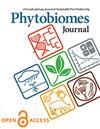Changes in bacterial communities and functions associated with litter degradation during forest succession caused by forest disease
IF 2.6
3区 生物学
Q2 MICROBIOLOGY
引用次数: 0
Abstract
Forest succession affects aboveground vegetation and belowground microbial community composition, in which litter degradation plays an important role in nutrient cycling. However, limited information is available on how microbial communities change during litter degradation in forests undergoing succession due to disease. In this study, the bacterial communities and functions in litter degradation along the forest succession from pure Pinus forest (PPF), mixed Pinus and Liquidambar forest (MPF and MLF) and pure Liquidambar forest (PLF) were investigated. The results showed the bacterial community richness and diversity in both needles/leaves and branch litters increased progressively with forest succession. Proteobacteria, Actinobacteria, Bacteroidetes, Acidobacteria were the most abundant bacterial phyla in the litter degradation along forest succession. The abundance of Bacteroidetes in branch increased significantly, while the abundance of genus Paraburkholderia decreased along forest succession. The different forests formed distinct bacterial community structures during litter decomposition. Functionally, chemoheterotrophy was the most abundant functional guild, followed by nitrogen fixation, intracellular parasitism and urealysis. The abundance of nitrogen fixation increased significantly along forest succession. Similarly, the different forests formed distinct bacterial functional structures in the needle/leaf along the succession. However, only two functional structures were formed in the branch. These results suggest that the bacterial community and its functions undergo significant changes during forest succession, particularly from the pure pine to mixed pine forest. These results provide a clear understanding of the changes in bacterial communities and functions during litter degradation in forests undergoing disease-induced succession.森林疾病引起的森林演替过程中与枯枝落叶退化相关的细菌群落和功能变化
森林演替影响地上植被和地下微生物群落组成,其中枯枝落叶的降解在养分循环中起着重要作用。然而,关于在因疾病而发生演替的森林中,微生物群落在枯枝落叶降解过程中如何变化的信息有限。本研究以纯松(PPF)、枫香混交林(MPF和MLF)和纯枫香林(PLF)为研究对象,研究了其在森林演替过程中的细菌群落及其在凋落物降解中的作用。结果表明,针叶和枯枝落叶中细菌群落的丰富度和多样性随森林演替而逐渐增加。变形菌门、放线菌门、拟杆菌门、酸杆菌门是森林演替过程中凋落物降解最丰富的细菌门。分枝中拟杆菌门的丰度显著增加,而副伯克霍尔德菌属的丰度则随着森林演替而下降。不同的森林在枯枝落叶分解过程中形成了不同的细菌群落结构。在功能上,化学异养是最丰富的功能组合,其次是固氮、细胞内寄生和解脲。森林演替过程中氮固定丰度显著增加。同样,不同的森林在演替过程中在针叶/叶片中形成了不同的细菌功能结构。然而,该分支中只形成了两个功能结构。这些结果表明,在森林演替过程中,细菌群落及其功能发生了显著变化,特别是从纯松林到混合松林。这些结果清楚地了解了在经历疾病诱导的演替的森林中,在枯枝落叶退化过程中细菌群落和功能的变化。
本文章由计算机程序翻译,如有差异,请以英文原文为准。
求助全文
约1分钟内获得全文
求助全文

 求助内容:
求助内容: 应助结果提醒方式:
应助结果提醒方式:


